Optimal Design, Characterization and Preliminary Safety Evaluation of an Edible Orodispersible Formulation for Pediatric Tuberculosis Pharmacotherapy
Abstract
1. Introduction
2. Results and Discussion
2.1. Orodispersible Formulation Variants
2.2. Selection and Validation of the Optimized Orodispersible Formulation
2.3. Physical Properties of Optimized Formulation
2.4. Drug Content and Release Behavior
2.5. Optimized Formulation Characterization
2.5.1. Thermal Behavior Using Differential Scanning Calorimetry and Thermogravimetry
2.5.2. Crystallinity
2.5.3. Structural Interpretation
2.5.4. BET Surface Area and Porosity
2.6. Typifying Surface Morphological Features and Transitioning with Hydration
2.7. Organoleptic Properties of Optimized Drug Loaded Formulation
2.8. Cytobiocompatibility Evaluation
2.9. Drug Formulation Stability under Changing Storage Conditions
3. Materials and Method
3.1. Materials
3.2. Experimental Design
3.2.1. Constructing the Box Behnken Design Template
3.2.2. Preparation of Orodispersible Formulations
3.2.3. Weight Determination for the Matrices
3.2.4. In Vitro Disintegration Time and Dissolution pH of the Matrices
3.3. Formulation Optimization
3.4. Physical Properties of the Optimized Orodispersible Formulation
3.4.1. Weight Determination
3.4.2. Measurement of Inner and Outer Diameter
3.4.3. Disintegration Time and Dissolution pH
3.5. Drug Content Analysis
3.6. Evaluation of In Vitro Drug Release Kinetics
3.7. Physicochemical Characterization
3.7.1. Differential Scanning Calorimetry (DSC)
3.7.2. Thermogravimetric Analysis (TGA)
3.7.3. Evaluation of Structural Transitions
3.7.4. Surface Area and Porosity Analyses
3.7.5. X-ray Diffraction (XRD)
3.8. Surface Conformational Transitions of Dry and Hydrated Formulations
3.9. Preliminary Organoleptic Evaluation
3.10. In Vitro Cytotoxicity Assay
3.10.1. Cell Culturing and Sample Preparation
3.10.2. MTT Cell Viability Assay
3.10.3. Neutral Red Cell Viability Assay
3.11. Stability Studies
4. Conclusions
Author Contributions
Funding
Acknowledgments
Conflicts of Interest
References
- World Health Organization. 2019. Available online: https://apps.who.int/iris/bitstream/handle/10665/329368/9789241565714-eng.pdf?ua=1 (accessed on 1 May 2020).
- Swaminathan, S.; Rekha, B. Paediatric tuberculosis: Global overview and challenges. Clin. Infect. Dis. 2010, 50, S184–S194. [Google Scholar] [CrossRef] [PubMed]
- Kumar, V.; Sharma, N.; Maitra, S.S. In vitro and in vivo toxicity assessment of nanoparticles. Int. Nano Lett. 2017, 7, 243–256. [Google Scholar] [CrossRef]
- Fogell, N. Tuberculosis: A disease without boundaries. Tuberculosis 2015, 95, 527–531. [Google Scholar] [CrossRef] [PubMed]
- Izudi, J.; Semakula, D.; Sennono, R.; Tamwesigire, I.K.; Bajunirwe, F. Treatment success rate among adult pulmonary tuberculosis patients in sub-Saharan Africa: A systematic review and meta-analysis. BMJ Open 2019, 9, 029400. [Google Scholar] [CrossRef] [PubMed]
- Peña, M.J.M.; García, B.S.; Baquero-Artigao, F.; Pérez, D.M.; Pérez, R.P.; Echevarría, A.M.; Amador, J.T.R.; Durán, D.G.-P.; Noguera-Julian, A. Tuberculosis treatment for children: An update. Anales de Pediatría 2018, 88, 52.e1–52.e12. [Google Scholar] [CrossRef]
- Graham, S.M. Treatment of paediatric TB: Revised WHO guidelines. Paediatr. Respir. Rev. 2011, 12, 22–26. [Google Scholar] [CrossRef]
- World Health Organization. 2018. Available online: https://www.who.int/tb/publications/global_report/gtbr2018_main_text_28Feb2019.pdf (accessed on 3 May 2019).
- Newton, S.M.; Brent, A.J.; Anderson, S.; Whittaker, E.; Kampmann, B. Paediatric tuberculosis. Lancet Infect. Dis. 2008, 8, 498–510. [Google Scholar] [CrossRef]
- Tsai, K.S.; Chang, H.L.; Chien, S.T.; Chen, K.L.; Chen, K.H.; Mai, M.H.; Chen, K.T. Childhood tuberculosis: Epidemiology, diagnosis, treatment, and vaccination. Paediatr. Neonatol. 2013, 54, 295–302. [Google Scholar] [CrossRef]
- Whittaker, E.; López-Varela, E.; Broderick, C.; Seddon, J.A. Examining the Complex Relationship between Tuberculosis and other Infectious Diseases in Children: A Review. Front. Paediatr. 2019, 7, 233. [Google Scholar] [CrossRef]
- Pouplin, T.; Phuong, P.N.; Van Toi, P.; Pouplin, J.N.; Farrar, J. Isoniazid, pyrazinamide and rifampicin content variation in split fixed-dose combination tablets. PLoS ONE 2014, 9, e102047. [Google Scholar] [CrossRef]
- Piñeiro Pérez, R.; Santiago García, B.; Fernández-Llamazares, C.M.; Baquero Artigao, F.; Noguera Julian, A.; Mellado Peña, M.J. The challenge of administering anti-tuberculosis treatment in infants and pre-school children. pTBred Magistral Project. Anales De Pediatría 2016, 85, 4–12. [Google Scholar] [CrossRef] [PubMed]
- World Health Organization. 2016. Available online: https://apps.who.int/iris/handle/10665/250441 (accessed on 7 May 2019).
- TB Alliance. 2020. Available online: https://www.tballiance.org/sites/default/files/assets/TB-Alliance_Child-Friendly-Medicines_pamphlet_2020.pdf (accessed on 12 February 2020).
- Sosnik, A.; Carcaboso, Á.M.; Glisoni, R.J.; Moretton, M.A.; Chiappetta, D.A. New old challenges in tuberculosis: Potentially effective nanotechnologies in drug delivery. Adv. Drug Deliv. Rev. 2010, 62, 547–559. [Google Scholar] [CrossRef] [PubMed]
- Svensson, E.M.; Yngman, G.; Denti, P.; McIlleron, H.; Kjellsson, M.C.; Karlsson, M.O. Evidence-based design of fixed-dose combinations: Principles and application to paediatric anti-tuberculosis therapy. Clin. Pharmacokinet. 2018, 57, 591–599. [Google Scholar] [CrossRef] [PubMed]
- Apis, V.; Landi, M.; Graham, S.M.; Islam, T.; Amini, J.; Sabumi, G.; Mandalakas, A.M.; Meae, T.; du Cros, P.; Shewade, H.D.; et al. Outcomes in children treated for tuberculosis with the new dispersible fixed-dose combinations in Port Moresby. Public Health Action 2019, 9, S32–S37. [Google Scholar] [CrossRef] [PubMed]
- Suárez-González, J.; Santoveña-Estévez, A.; Soriano, M.; Fariña, J.B. Design and optimization of a child-friendly dispersible tablet containing Isoniazid, Pyrazinamide and Rifampicin for treating Tuberculosis in paediatrics. Drug Dev. Ind. Pharm. 2020, 46, 309–317. [Google Scholar] [CrossRef]
- Martir, J.; Flanagan, T.; Mann, J.; Fotaki, N. Recommended strategies for the oral administration of paediatric medicines with food and drinks in the context of their biopharmaceutical properties: A review. J. Pharm. Pharmacol. 2017, 69, 384–397. [Google Scholar] [CrossRef]
- Craig, S.R.; Adams, L.V.; Spielberg, S.P.; Campbell, B. Paediatric therapeutics and medicine administration in resource-poor settings: A review of barriers and an agenda for interdisciplinary approaches to improving outcomes. Soc. Sci. Med. 2009, 69, 1681–1690. [Google Scholar] [CrossRef]
- Ivanovska, V.; Rademaker, C.M.; van Dijk, L.; Mantel-Teeuwisse, A.K. Paediatric drug formulations: A review of challenges and progress. Paediatrics 2014, 134, 361–372. [Google Scholar] [CrossRef]
- Singh, J.; Philip, A.K.; Pathak, K. Optimization Studies on Design and Evaluation of Orodispersible Peadiatric Formulation of Indomethacin. AAPS Pharm. Sci. Tech. 2008, 9, 60–66. [Google Scholar] [CrossRef]
- World Health Organization. 2017. Available online: https://www.who.int/tb/publications/global_report/gtbr2017_main_text.pdf?ua=1 (accessed on 25 April 2020).
- Lopez, F.L.; Ernest, T.B.; Tuleu, C.; Gul, M.O. Formulation approaches to paediatric oral drug delivery: Benefits and limitations of current platforms. Expert Opin. Drug Deliv. 2015, 12, 1727–1740. [Google Scholar] [CrossRef]
- Preis, M.; Woertz, C.; Schneider, K.; Kukawka, J.; Broscheit, J.; Roewer, N.; Breitkreutz, J. Design and evaluation of bilayered buccal film preparations for local administration of lidocaine hydrochloride. Eur. J. Pharm. Biopharm. 2014, 86, 552–561. [Google Scholar] [CrossRef]
- Slavkova, M.; Breitkreutz, J. Orodispersible drug formulations for children and elderly. Eur. J. Pharm. Sci. 2015, 75, 2–9. [Google Scholar] [CrossRef] [PubMed]
- Senta-Loys, Z.; Bourgeois, S.; Pailler-Mattei, C.; Agusti, G.; Briançon, S.; Fessi, H. Formulation of orodispersible films for paediatric therapy: Investigation of feasibility and stability for tetrabenazine as drug model. J. Pharm. Pharmacol. 2017, 69, 582–592. [Google Scholar] [CrossRef] [PubMed]
- Ibrahim, H.K.; El-Setouhy, D.A. Valsartan orodispersible tablets: Formulation, in vitro/in vivo characterization. AAPS Pharm. Sci. Tech. 2010, 11, 189–196. [Google Scholar] [CrossRef] [PubMed]
- Singh, B.; Bhatowa, R.; Tripathi, C.B.; Kapil, R. Developing micro-/nanoparticulate drug delivery systems using “design of experiments”. Int. J. Pharm. Investig. 2011, 1, 75. [Google Scholar] [CrossRef]
- Bala, R.; Khanna, S.; Pawar, P. Design optimization and in vitro-in vivo evaluation of orally dissolving strips of clobazam. J. Drug Deliv. 2014, 2014, 1–15. [Google Scholar] [CrossRef] [PubMed]
- Zhang, Y.; Mitchison, D. The curious characteristics of pyrazinamide: A review. Int. J. Tuberc. Lung Dis. 2003, 7, 6–12. [Google Scholar] [PubMed]
- Ando, H.; Mitarai, S.; Kondo, Y.; Suetake, T.; Sekiguchi, J.I.; Kato, S.; Mori, T.; Kirikae, T. Pyrazinamide resistance in multidrug-resistant Mycobacterium tuberculosis isolates in Japan. Clin. Microbiol. Infect. 2010, 16, 1164–1168. [Google Scholar] [CrossRef] [PubMed]
- Zhang, Y.; Shi, W.; Zhang, W.; Mitchison, D. Mechanisms of pyrazinamide action and resistance. Microbiol. Spectr. 2013, 2, 1–12. [Google Scholar]
- Hu, L.; Sun, C.; Song, A.; Chang, D.; Zheng, X.; Gao, Y.; Jiang, T.; Wang, S. Alginate encapsulated mesoporous silica nanospheres as a sustained drug delivery system for the poorly water-soluble drug indomethacin. Asian J. Pharm. Sci. 2014, 9, 183–190. [Google Scholar] [CrossRef]
- Becker, C.; Dressman, J.B.; Amidon, G.L.; Junginger, H.E.; Kopp, S.; Midha, K.K.; Shah, V.P.; Stavchansky, S.; Barends, D.M. Biowaiver monographs for immediate release solid oral dosage forms: Pyrazinamide. J. Pharm. Sci. 2008, 97, 3709–3720. [Google Scholar] [CrossRef] [PubMed]
- Mitchison, D.A.; Fourie, P.B. The near future: Improving the activity of rifamycins and pyrazinamide. Tuberculosis 2010, 90, 177–181. [Google Scholar] [CrossRef] [PubMed]
- Adeleke, O.A.; Monama, N.O.; Tsai, P.C.; Sithole, H.M.; Michniak-Kohn, B.B. Combined atomistic molecular calculations and experimental investigations for the architecture, screening, optimization, and characterization of pyrazinamide containing oral film formulations for tuberculosis management. Mol. Pharm. 2016, 13, 456–471. [Google Scholar] [CrossRef] [PubMed]
- Chirehwa, M.T.; McIlleron, H.; Rustomjee, R.; Mthiyane, T.; Onyebujoh, P.; Smith, P.; Denti, P. Pharmacokinetics of pyrazinamide and optimal dosing regimens for drug-sensitive and-resistant tuberculosis. Antimicrob. Agents Chemother. 2017, 61, 00490–17. [Google Scholar] [CrossRef]
- Adeleke, O.A.; Tsai, P.C.; Karry, K.M.; Monama, N.O.; Michniak-Kohn, B.B. Isoniazid-loaded orodispersible strips: Methodical design, optimization and in vitro-in silico characterization. Int. J. Pharm. 2018, 547, 347–359. [Google Scholar] [CrossRef]
- Zhu, Y.; You, X.; Huang, K.; Raza, F.; Lu, X.; Chen, Y.; Dhinakar, A.; Zhang, Y.; Kang, Y.; Wu, J.; et al. Effect of taste masking technology on fast dissolving oral film: Dissolution rate and bioavailability. Nanotechnology 2018, 29, 304001. [Google Scholar] [CrossRef]
- Dixit, R.P.; Puthli, S.P. Oral strip technology: Overview and future potential. J. Control. Release 2009, 139, 94–107. [Google Scholar] [CrossRef]
- Sadoun, O.; Rezgui, F.; G’Sell, C. Optimization of valsartan encapsulation in biodegradables polyesters using Box-Behnken design. Mater. Sci. Eng. C 2018, 90, 189–197. [Google Scholar] [CrossRef]
- Ranch, K.M.; Maulvi, F.A.; Naik, M.J.; Koli, A.R.; Parikh, R.K.; Shah, D.O. Optimization of a novel in situ gel for sustained ocular drug delivery using Box-Behnken design: In vitro, ex vivo, in vivo and human studies. Int. J. Pharm. 2019, 554, 264–275. [Google Scholar] [CrossRef]
- Ciro, Y.; Rojas, J.; Alhajj, M.J.; Carabali, G.A.; Salamanca, C.H. Production and Characterization of Chitosan–Polyanion Nanoparticles by Polyelectrolyte Complexation Assisted by High-Intensity Sonication for the Modified Release of Methotrexate. Pharmaceuticals 2020, 13, 11. [Google Scholar] [CrossRef]
- Cherukuvada, S.; Thakuria, R.; Nangia, A. Pyrazinamide polymorphs: Relative stability and vibrational spectroscopy. Cryst. Growth Des. 2010, 10, 3931–3941. [Google Scholar] [CrossRef]
- Eedara, B.B.; Tucker, I.G.; Das, S.C. Phospholipid-based pyrazinamide spray-dried inhalable powders for treating tuberculosis. Int. J. Pharm. 2016, 506, 174–183. [Google Scholar] [CrossRef] [PubMed]
- Alshehri, S.M.; Park, J.B.; Alsulays, B.B.; Tiwari, R.V.; Almutairy, B.; Alshetaili, A.S.; Morott, J.; Shah, S.; Kulkarni, V.; Majumdar, S.; et al. Mefenamic acid taste-masked oral disintegrating tablets with enhanced solubility via molecular interaction produced by hot melt extrusion technology. J. Drug Deliv. Sci. Technol. 2015, 27, 18–27. [Google Scholar] [CrossRef] [PubMed]
- Reddy, K.A.; Karpagam, S. Cellulose orodispersible films of donepezil: Film characterization and drug release. Pharm. Chem. J. 2017, 51, 707–715. [Google Scholar] [CrossRef]
- Eedara, B.B.; Rangnekar, B.; Sinha, S.; Doyle, C.; Cavallaro, A.; Das, S.C. Development and characterization of high payload combination dry powders of anti-tubercular drugs for treating pulmonary tuberculosis. Eur. J. Pharm. Sci. 2018, 118, 216–226. [Google Scholar] [CrossRef] [PubMed]
- Demitri, C.; Del Sole, R.; Scalera, F.; Sannino, A.; Vasapollo, G.; Maffezzoli, A.; Ambrosio, L.; Nicolais, L. Novel superabsorbent cellulose-based hydrogels crosslinked with citric acid. J. Appl. Polym. Sci. 2008, 110, 2453–2460. [Google Scholar] [CrossRef]
- Santos, M.G.; Bozza, F.T.; Thomazini, M.; Favaro-Trindade, C.S. Microencapsulation of xylitol by double emulsion followed by complex coacervation. Food Chem. 2015, 171, 32–39. [Google Scholar] [CrossRef]
- Salehi, S.; Boddohi, S. Design and optimization of Kollicoat® IR based mucoadhesive buccal film for co-delivery of rizatriptan benzoate and propranolol hydrochloride. Mater. Sci Eng. C 2019, 97, 230–244. [Google Scholar] [CrossRef]
- Gunasekaran, S.; Sailatha, E. Vibrational analysis of pyrazinamide. Indian J. Pure Appl. Phys. 2009, 47, 259–264. [Google Scholar]
- Tang, Q.; Xu, Y.; Wu, D.; Sun, Y. A study of carboxylic-modified mesoporous silica in controlled delivery for drug famotidine. J. Solid State Chem. 2006, 179, 1513–1520. [Google Scholar] [CrossRef]
- Fotakis, G.; Timbrell, J.A. In vitro cytotoxicity assays: Comparison of LDH, neutral red, MTT and protein assay in hepatoma cell lines following exposure to cadmium chloride. Toxicol. Lett. 2006, 160, 171–177. [Google Scholar] [CrossRef] [PubMed]
- Mosmann, T. Rapid colorimetric assay for cellular growth and survival: Application to proliferation and cytotoxicity assays. J. Immunol. Methods 1983, 65, 55–63. [Google Scholar] [CrossRef]
- Elje, E.; Mariussen, E.; Moriones, O.H.; Bastús, N.G.; Puntes, V.; Kohl, Y.; Dusinska, M.; Rundén-Pran, E. Hepato (Geno) Toxicity assessment of nanoparticles in a HepG2 liver spheroid model. Nanomaterials 2020, 10, 545. [Google Scholar] [CrossRef] [PubMed]
- Van Tonder, A.; Joubert, A.M.; Cromarty, A.D. Limitations of the 3-(4, 5-dimethylthiazol-2-yl)-2, 5-diphenyl-2H-tetrazolium bromide (MTT) assay when compared to three commonly used cell enumeration assays. BMC Res. Notes 2015, 8, 47. [Google Scholar] [CrossRef] [PubMed]
- Adeleke, O.A.; Hayeshi, R.K.; Davids, H. Development and evaluation of a reconstitutable dry suspension containing isoniazid for flexible paediatric dosing. Pharmaceutics 2020, 12, 286. [Google Scholar] [CrossRef] [PubMed]
- Jana, A.; Maity, C.; Halder, S.K.; Mondal, K.C.; Pati, B.R.; Mohapatra, P.K.D. Tannase production by Penicillium purpurogenum PAF6 in solid state fermentation of tannin-rich plant residues following OVAT and RSM. Appl. Biochem. Biotechnol. 2012, 167, 1254–1269. [Google Scholar] [CrossRef]
- Fachel, F.N.S.; Medeiros-Neves, B.; Dal Prá, M.; Schuh, R.S.; Veras, K.S.; Bassani, V.L.; Koester, L.S.; Henriques, A.T.; Braganhol, E.; Teixeira, H.F. Box-Behnken design optimization of mucoadhesive chitosan-coated nanoemulsions for rosmarinic acid nasal delivery-In vitro studies. Carbohydr. Polym. 2018, 199, 572–582. [Google Scholar] [CrossRef]
- Garsuch, V.; Breitkreutz, J. Comparative investigations on different polymers for the preparation of fast-dissolving oral films. J. Pharm. Pharmacol. 2010, 62, 539–545. [Google Scholar] [CrossRef]
- Brniak, W.; Maślak, E.; Jachowicz, R. Orodispersible films and tablets with prednisolone microparticles. Eur. J. Pharm. Sci. 2015, 75, 81–90. [Google Scholar] [CrossRef]
- Koland, M.; Charyulu, R.N.; Vijayanarayana, K.; Prabhu, P. In vitro and in vivo evaluation of chitosan buccal films of ondansetron hydrochloride. Int. J. Pharm. Investig. 2011, 3, 164. [Google Scholar] [CrossRef]
- Tomar, A.; Sharma, K.; Chauhan, N.S.; Mittal, A.; Bajaj, U. Formulation and evaluation of fast dissolving oral film of dicyclomine as potential route of buccal delivery. Int. J. Drug Dev. Res. 2012, 4, 408–417. [Google Scholar]
- Wójcik-Pastuszka, D.; Krzak, J.; Macikowski, B.; Berkowski, R.; Osiński, B.; Musiał, W. Evaluation of the Release Kinetics of a Pharmacologically Active Substance from Model Intra-Articular Implants Replacing the Cruciate Ligaments of the Knee. Materials 2019, 12, 1202. [Google Scholar] [CrossRef] [PubMed]
- Saxena, S.; Gautam, S.; Sharma, A. Microbial decontamination of honey of Indian origin using gamma radiation and its biochemical and organoleptic properties. J. Food Sci. 2010, 75, M19–M27. [Google Scholar] [CrossRef] [PubMed]
- Khadra, I.; Obeid, M.A.; Dunn, C.; Watts, S.; Halbert, G.; Ford, S.; Mullen, A. Characterisation and optimisation of diclofenac sodium orodispersible thin film formulation. Int. J. Pharm. 2019, 561, 43–46. [Google Scholar] [CrossRef] [PubMed]
- Vistica, D.T.; Skehan, P.; Scudiero, D.; Monks, A.; Pittman, A.; Boyd, M.R. Tetrazolium-based assays for cellular viability: A critical examination of selected parameters affecting formazan production. Cancer Res. 1991, 51, 2515–2520. [Google Scholar] [PubMed]
- Markens, U.; Asia-Pacific, R.H. Conducting stability studies-recent changes to climatic zone IV. Life Sci. Tech. Bull. 2009, 13, 1–4. [Google Scholar]
- Williams, H.E.; Bright, J.; Roddy, E.; Poulton, A.; Cosgrove, S.D.; Turner, F.; Harrison, P.; Brookes, A.; MacDougall, E.; Abbott, A.; et al. A comparison of drug substance predicted chemical stability with ICH compliant stability studies. Drug Dev. Ind. Pharm. 2018, 45, 379–386. [Google Scholar] [CrossRef]
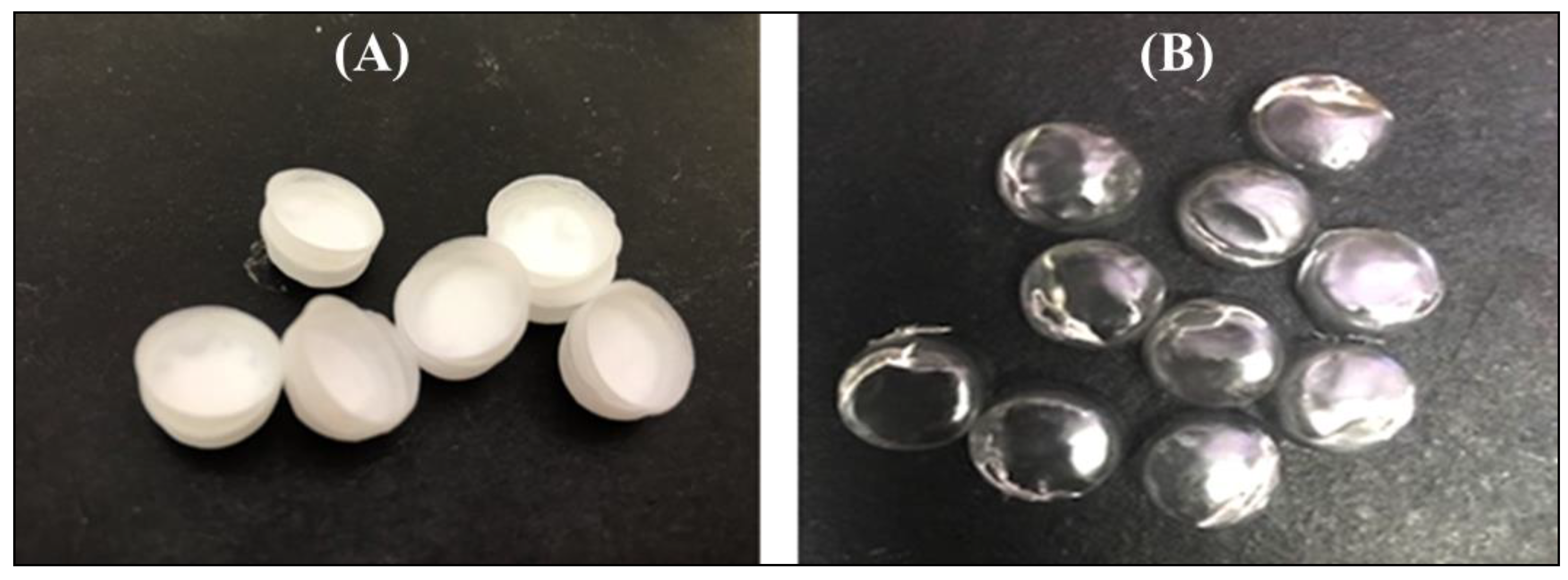
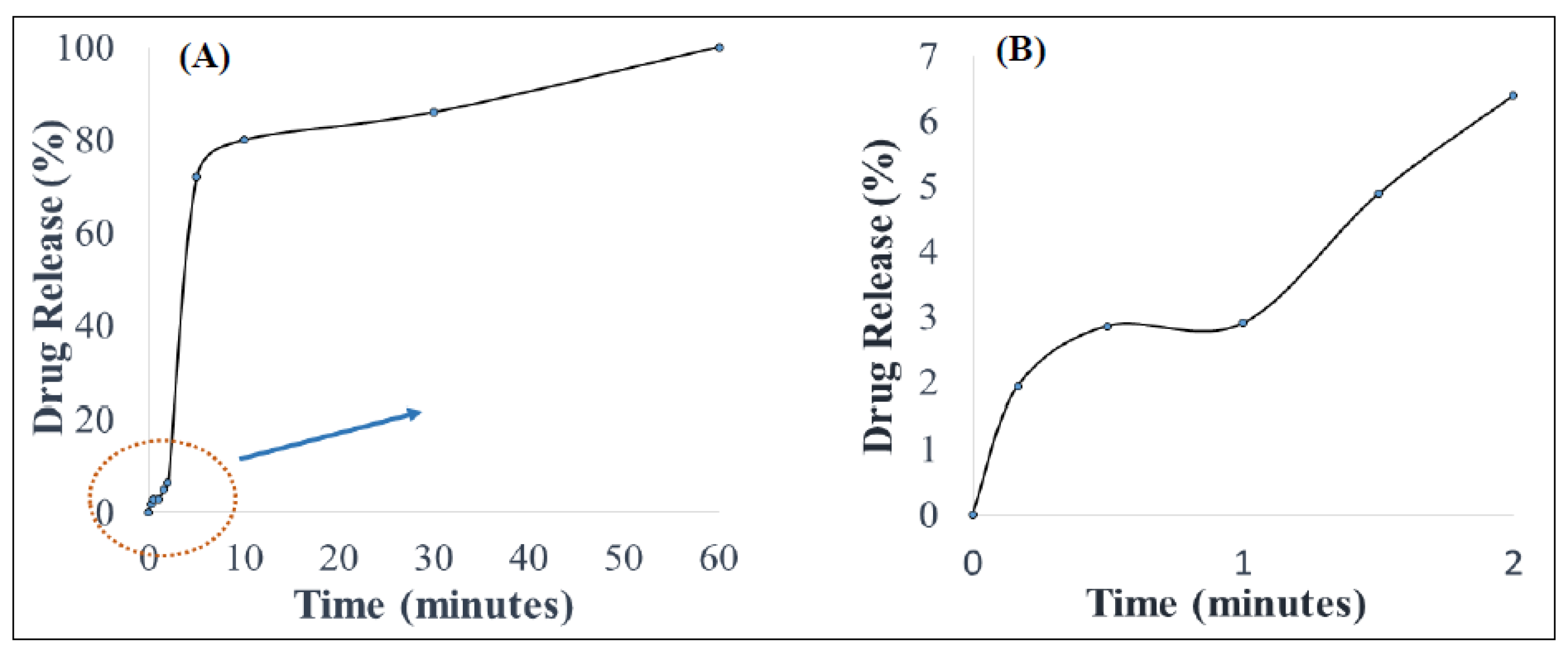
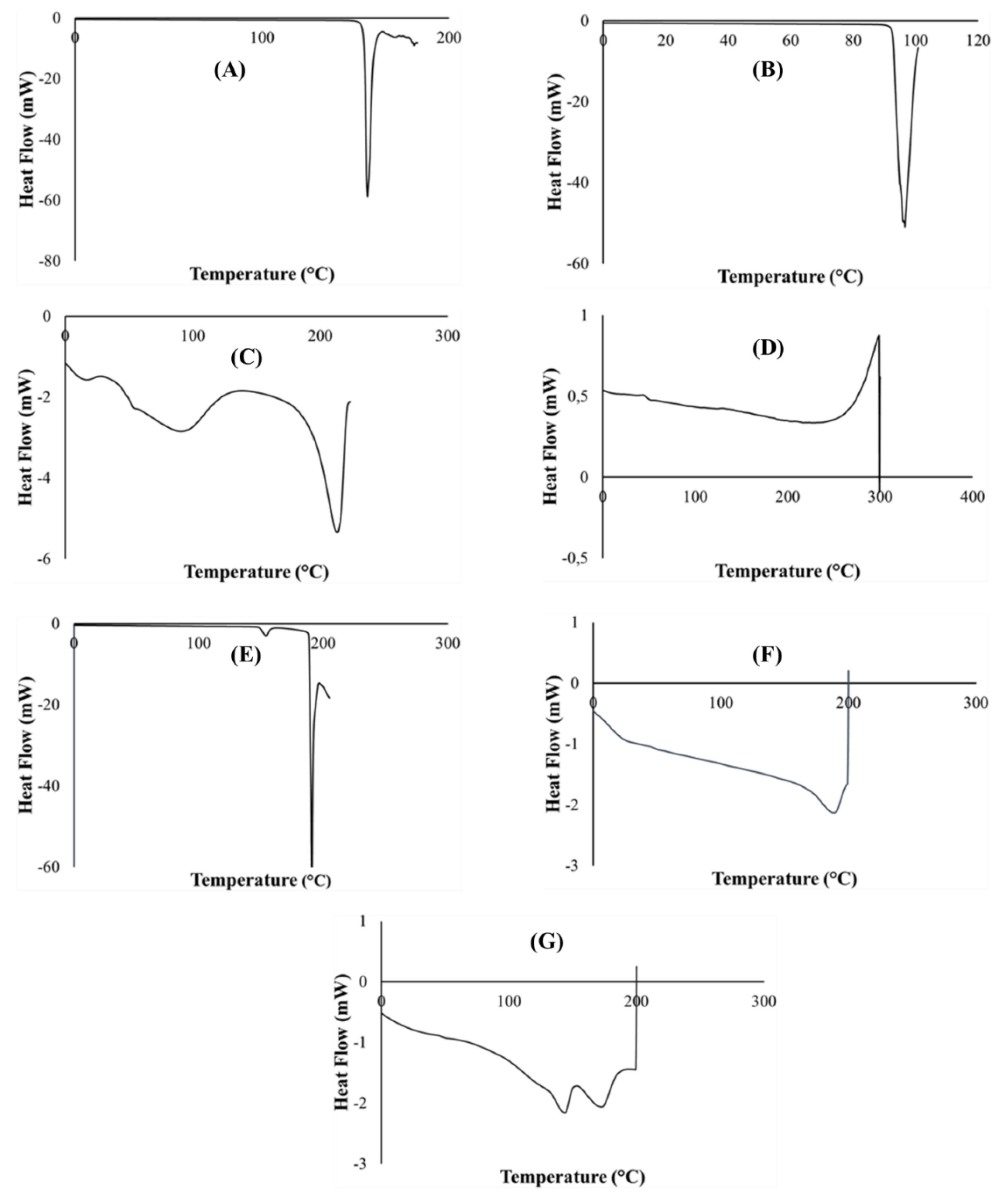

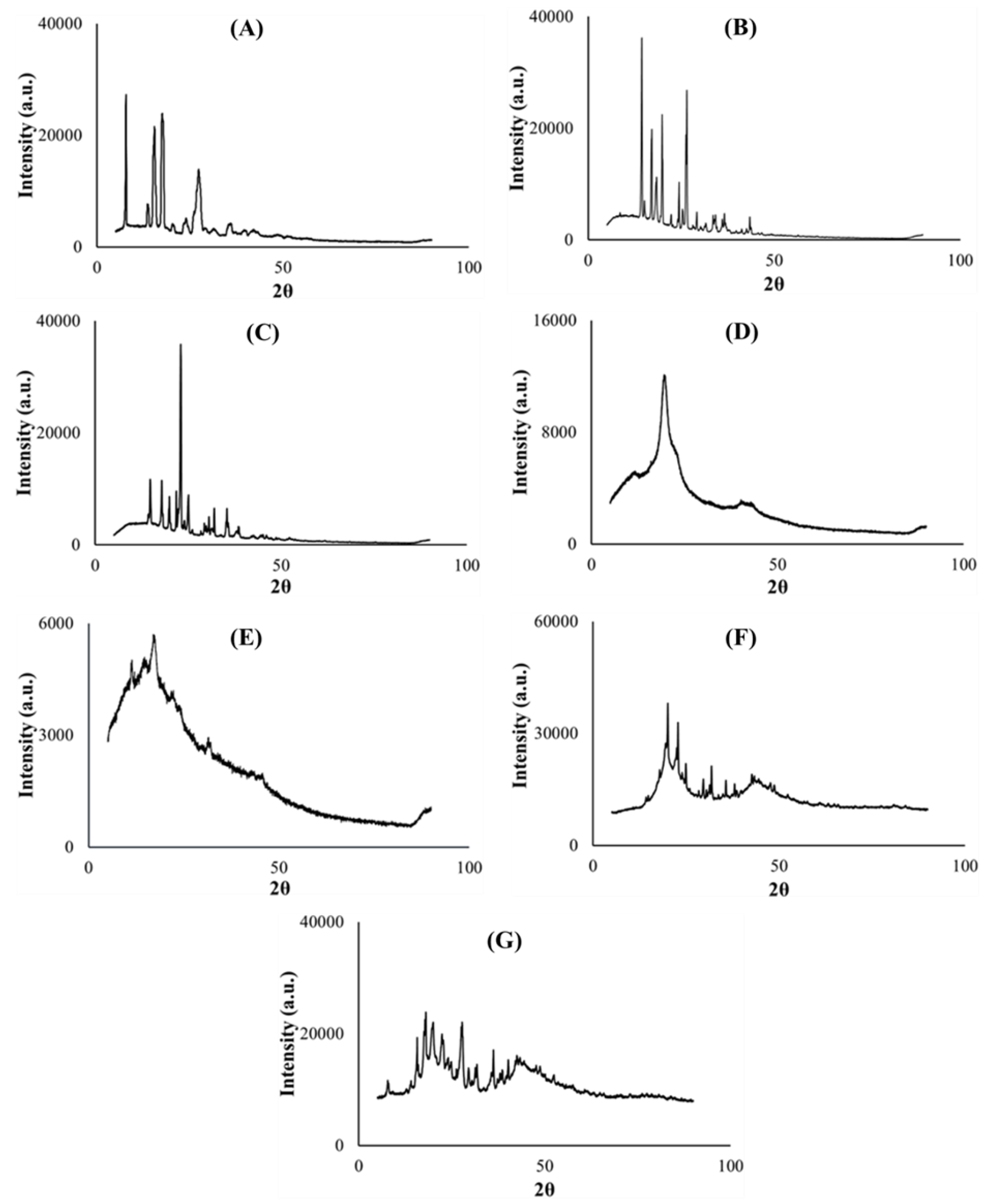
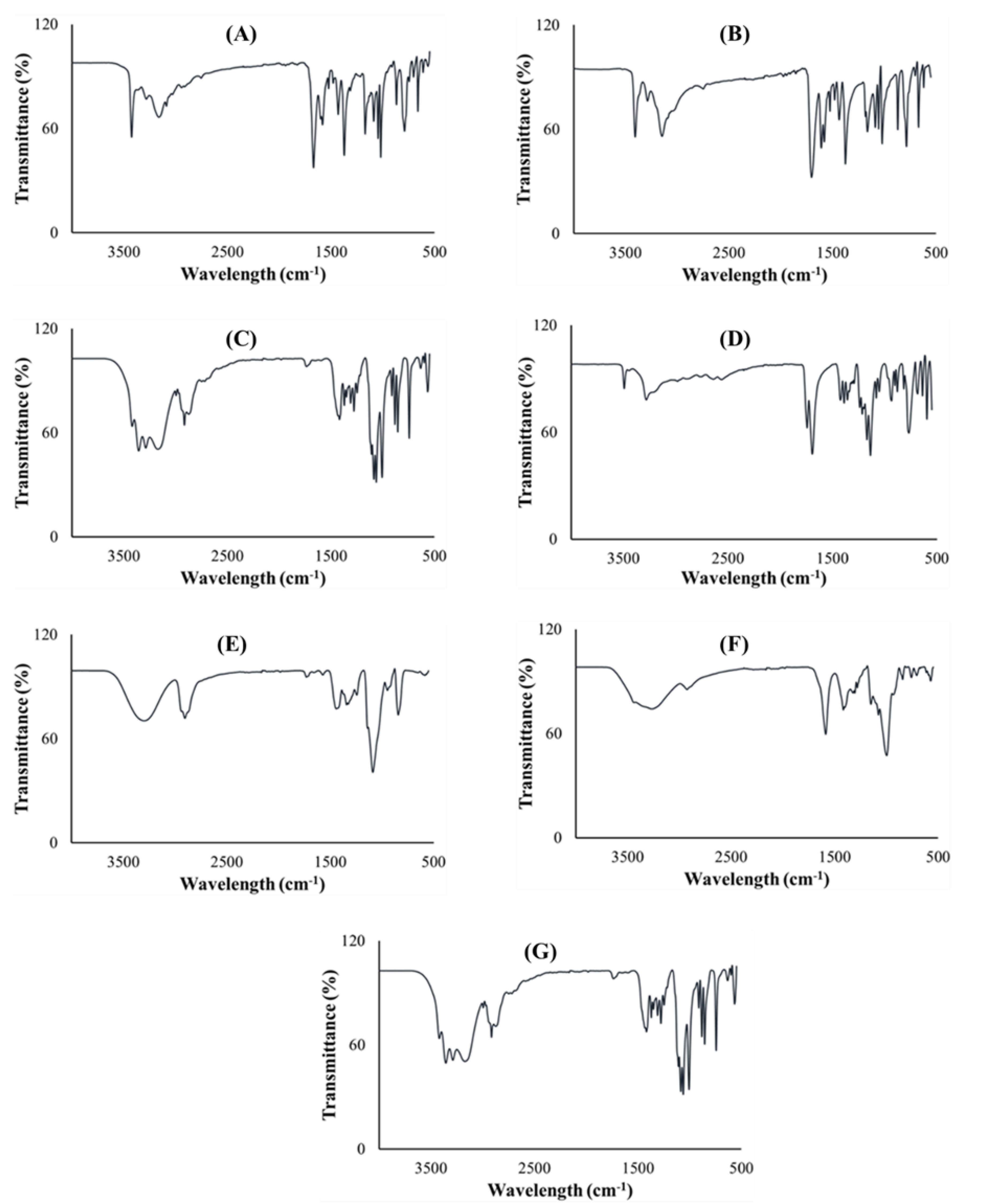
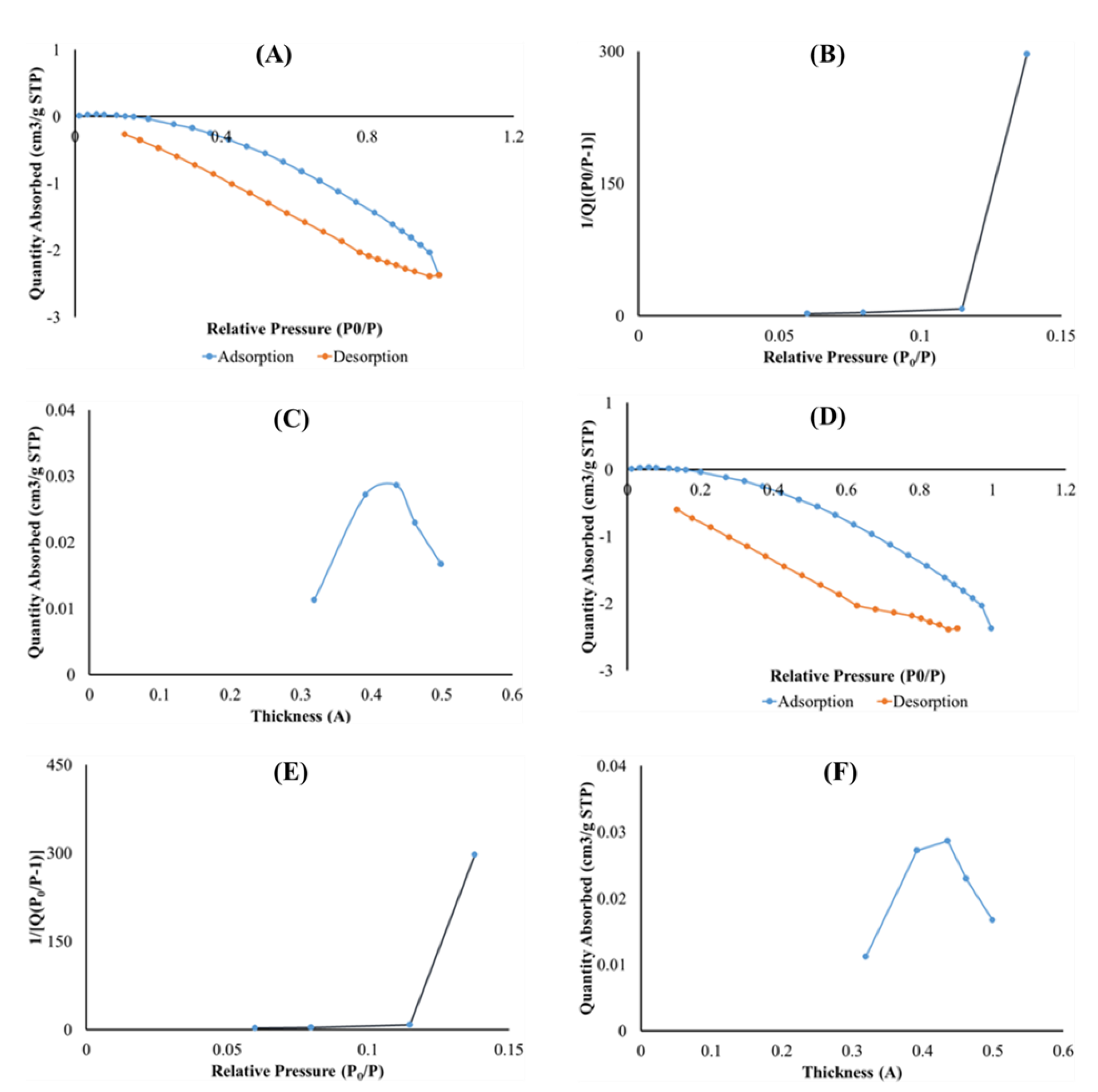
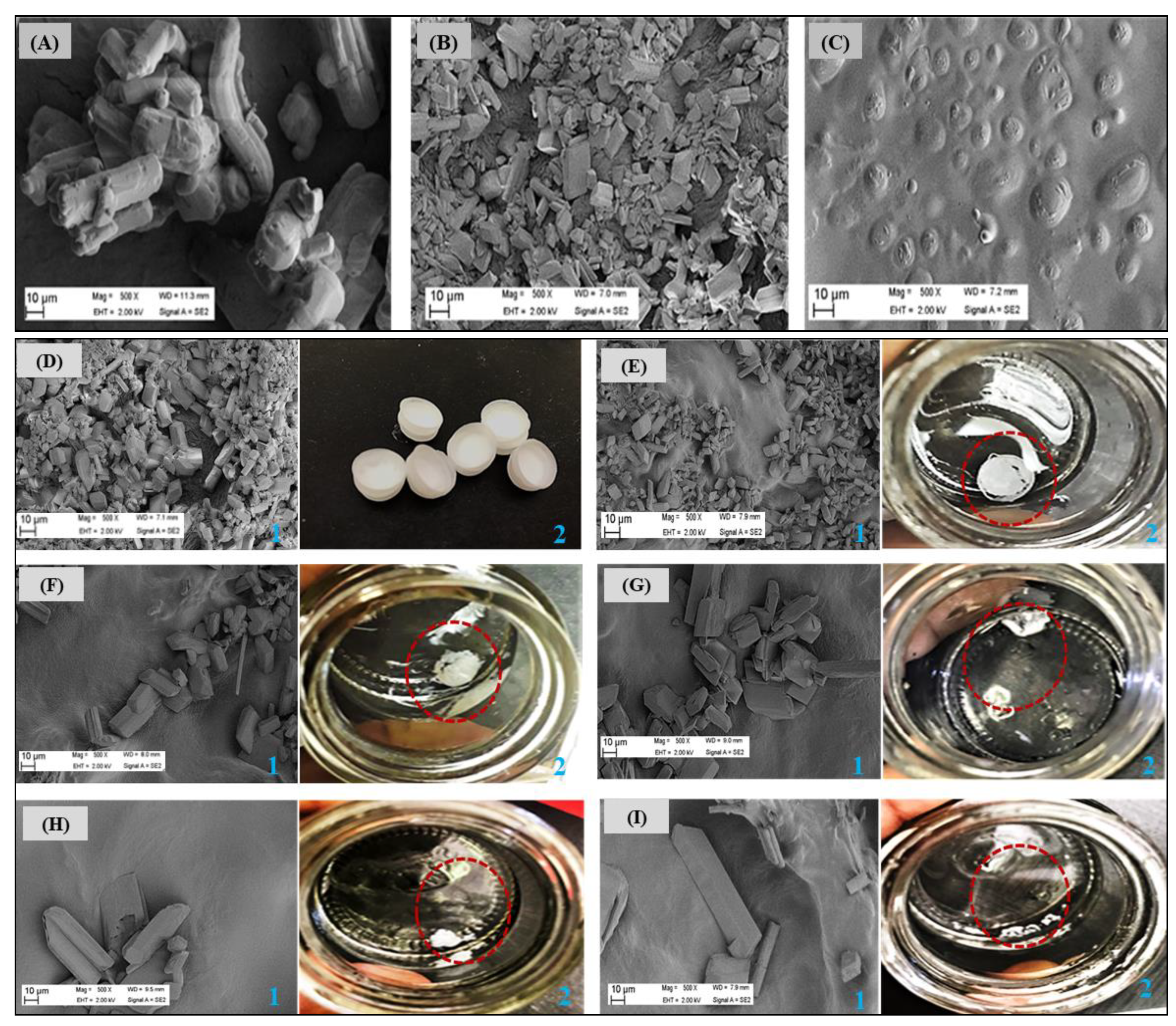
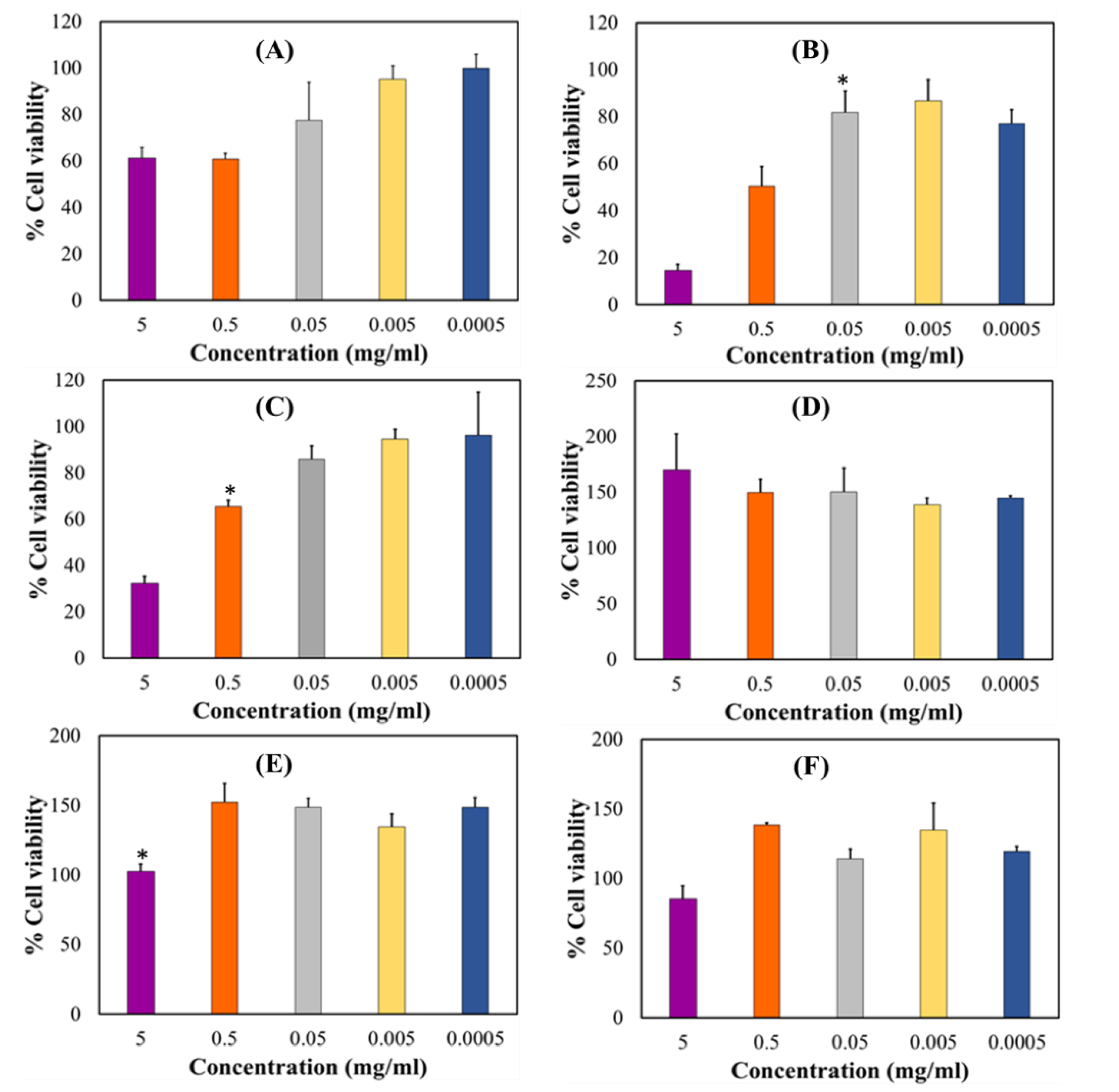
| Formulation | Weight (mg) | Disintegration Time (minutes) | Dissolution pH |
|---|---|---|---|
| F1 | 91.66 ± 1.55 | 2.57 ± 0.34 | 7.33 ± 0.02 |
| F2 | 65.60 ± 2.58 | 0.47 ± 0.15 | 6.69 ± 0.04 |
| F3 | 106.80 ± 2.00 | 1.59 ± 0.50 | 7.04 ± 0.02 |
| F4 | 100.00 ± 2.38 | 1.24 ± 0.23 | 6.96 ± 0.05 |
| F5 | 105.83 ± 3.95 | 1.72 ± 0.42 | 6.78 ± 0.04 |
| F6* | 87.86 ± 2.11 | 1.50 ± 0.09 | 6.59 ± 0.23 |
| F7 | 75.07 ± 4.45 | 1.19 ± 0.06 | 6.94 ± 0.02 |
| F8 | 60.87 ± 3.80 | 0.44 ± 0.04 | 6.96 ± 0.03 |
| F9* | 86.50 ± 2.59 | 1.45 ± 0.24 | 6.83 ± 0.06 |
| F10 | 81.23 ± 1.64 | 3.46 ±0.51 | 6.98 ± 0.01 |
| F11 | 81.50 ± 1.64 | 5.40 ± 0.10 | 7.30 ± 0.03 |
| F12 | 84.77 ± 6.96 | 1.94 ± 0.62 | 7.06 ± 0.03 |
| F13 | 112.06 ± 18.98 | 3.62 ±2.90 | 7.23 ± 0.14 |
| F14 | 121.4 ± 8.00 | 5.44 ± 0.14 | 7.01 ± 0.06 |
| F15 | 101.33 ± 4.51 | 4.84 ± 0.37 | 6.70 ± 0.06 |
| F16 | 82.63 ± 0.06 | 4.20 ± 0.13 | 7.29 ± 0.03 |
| F17 | 82.07 ± 3.04 | 5.03 ± 1.02 | 7.07 ± 0.03 |
| F18 | 73.67 ± 3.16 | 4.83 ± 1.54 | 7.05 ± 0.02 |
| F19 | 77.3 ± 1.42 | 4.02 ± 0.58 | 7.02 ± 0.06 |
| F20 | 77.3 ± 14.03 | 2.58 ± 0.53 | 6.95 ± 0.06 |
| F21 | 109.47 ± 2.39 | 2.57 ± 1.28 | 7.33 ± 0.41 |
| F22 | 98.23 ± 15.06 | 2.73 ± 1.54 | 7.00 ± 0.05 |
| F23* | 90.30 ± 1.34 | 1.08 ± 0.10 | 7.10 ± 0.01 |
| F24 | 80.97 ± 1.23 | 1.67 ± 0.57 | 7.43 ± 0.01 |
| F25 | 114.97 ± 10.08 | 5.67 ± 0.42 | 7.05 ± 0.04 |
| F26 | 78.40 ± 5.56 | 0.20 ± 0.09 | 7.02 ± 0.05 |
| F27 | 70.37 ± 3.75 | 0.72 ± 0.34 | 7.41 ± 0.06 |
| Optimized Formula | Validation of Predicted Outputs with Experimental Values (n = 3) | |||
|---|---|---|---|---|
| Factor Levels | Responses | Desirability Level | Predicted | Observed |
| X1 = 1.000 g | Y1 | 0.980 | 0.620 min | 0.583 ± 0.050 min |
| X2 = 0.483 g | Y2 | 1.000 | 7.000 | 6.900 ± 0.250 |
| X3 = 0.058 g | Y3 | 0.994 | 65.333 mg | 57.500 ± 0.002 mg |
| X4 = 0.539 g | ||||
| Stability Indicators | 0 Weeks | Varying Storage Conditions at 12 Weeks | ||
|---|---|---|---|---|
| I * | II * | III * | ||
| Mass (mg) | 57.500 ± 0.002 | 56.100 ± 0.472 | 58.600 ± 0.321 | 58.530 ± 1.531 |
| Outer diameter (mm) | 11.000 ± 0.426 | 11.000 ± 0.577 | 11.000 ± 0.577 | 11.667 ± 0.577 |
| Inner diameter (mm) | 10.000 ± 0.520 | 10.000 ± 0.577 | 10.000 ± 0.577 | 10.667 ± 0.577 |
| Disintegration time (min) | 0.583 ± 0.050 | 0.533 ± 2.510 | 0.467 ± 3.050 | 0.483 ± 1.154 |
| Dissolution pH | 6.900 ± 0.250 | 7.290 ± 0.0.015 | 7.640 ± 0.071 | 7.633 ± 0.041 |
| % drug content | 101.000 ± 2.030 | 88.000 ± 15.530 | 84.000 ± 3.020 | 33.333 ± 10.408 |
| Colour change | None | None | None | Yes |
| Independent Variables | Levels | ||
|---|---|---|---|
| −1 | 0 | +1 | |
| X1: Polyvinyl alcohol polyethylene glycol (g) | 1.000 | 2.000 | 3.000 |
| X2: Sodium starch glycolate (g) | 0.000 | 0.500 | 1.000 |
| X3: Citric acid (g) | 0.025 | 0.063 | 0.100 |
| X4: Xylitol (g) | 0.300 | 0.650 | 1.000 |
| Formulation | X1 | X2 | X3 | X4 |
|---|---|---|---|---|
| F1 | 3.0000 | 0.5000 | 0.0250 | 0.6500 |
| F2 | 2.0000 | 1.0000 | 0.0625 | 1.0000 |
| F3 | 3.0000 | 1.0000 | 0.0625 | 0.6500 |
| F4 | 1.0000 | 0.5000 | 0.1000 | 0.6500 |
| F5 | 3.0000 | 0.5000 | 0.1000 | 0.6500 |
| F6 * | 2.0000 | 0.5000 | 0.0625 | 0.6500 |
| F7 | 1.0000 | 1.0000 | 0.0625 | 0.6500 |
| F8 | 1.0000 | 0.5000 | 0.0625 | 0.3000 |
| F9 * | 2.0000 | 0.5000 | 0.0625 | 0.6500 |
| F10 | 2.0000 | 0.5000 | 0.1000 | 0.3000 |
| F11 | 2.0000 | 0.0000 | 0.0250 | 0.6500 |
| F12 | 2.0000 | 1.0000 | 0.0625 | 0.3000 |
| F13 | 2.0000 | 0.5000 | 0.0250 | 1.0000 |
| F14 | 1.0000 | 0.0000 | 0.0625 | 0.6500 |
| F15 | 3.0000 | 0.5000 | 0.0625 | 0.3000 |
| F16 | 2.0000 | 1.0000 | 0.0250 | 0.6500 |
| F17 | 2.0000 | 0.0000 | 0.0625 | 1.0000 |
| F18 | 2.0000 | 0.0000 | 0.0625 | 0.3000 |
| F19 | 2.0000 | 0.0000 | 0.1000 | 0.6500 |
| F20 | 2.0000 | 0.5000 | 0.1000 | 1.0000 |
| F21 | 3.0000 | 0.5000 | 0.0625 | 1.0000 |
| F22 | 3.0000 | 0.0000 | 0.0625 | 0.6500 |
| F23 * | 2.0000 | 0.5000 | 0.0625 | 0.6500 |
| F24 | 2.0000 | 0.5000 | 0.0250 | 0.3000 |
| F25 | 2.0000 | 1.0000 | 0.1000 | 0.6500 |
| F26 | 1.0000 | 0.5000 | 0.0625 | 1.0000 |
| F27 | 1.0000 | 0.5000 | 0.0250 | 0.6500 |
| Dependent Variables | Constrain | Lower | Upper | Goal | R | p-Value |
|---|---|---|---|---|---|---|
| Y1: Disintegration time (minutes) | Minimize | 0.500 | 0.700 | 0.600 | 0.910 | 0.002 |
| Y2: Disintegration pH | Target | 6.900 | 7.100 | 7.000 | 0.940 | 0.001 |
| Y3: Formulation weight (mg) | Minimize | 50.00 | 70.00 | 60.00 | 0.901 | 0.020 |
© 2020 by the authors. Licensee MDPI, Basel, Switzerland. This article is an open access article distributed under the terms and conditions of the Creative Commons Attribution (CC BY) license (http://creativecommons.org/licenses/by/4.0/).
Share and Cite
Matawo, N.; Adeleke, O.A.; Wesley-Smith, J. Optimal Design, Characterization and Preliminary Safety Evaluation of an Edible Orodispersible Formulation for Pediatric Tuberculosis Pharmacotherapy. Int. J. Mol. Sci. 2020, 21, 5714. https://doi.org/10.3390/ijms21165714
Matawo N, Adeleke OA, Wesley-Smith J. Optimal Design, Characterization and Preliminary Safety Evaluation of an Edible Orodispersible Formulation for Pediatric Tuberculosis Pharmacotherapy. International Journal of Molecular Sciences. 2020; 21(16):5714. https://doi.org/10.3390/ijms21165714
Chicago/Turabian StyleMatawo, Nyaradzo, Oluwatoyin A. Adeleke, and James Wesley-Smith. 2020. "Optimal Design, Characterization and Preliminary Safety Evaluation of an Edible Orodispersible Formulation for Pediatric Tuberculosis Pharmacotherapy" International Journal of Molecular Sciences 21, no. 16: 5714. https://doi.org/10.3390/ijms21165714
APA StyleMatawo, N., Adeleke, O. A., & Wesley-Smith, J. (2020). Optimal Design, Characterization and Preliminary Safety Evaluation of an Edible Orodispersible Formulation for Pediatric Tuberculosis Pharmacotherapy. International Journal of Molecular Sciences, 21(16), 5714. https://doi.org/10.3390/ijms21165714






